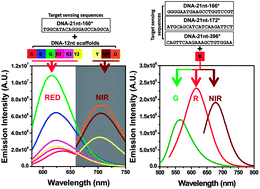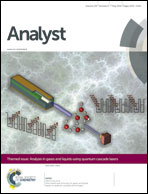In-solution multiplex miRNA detection using DNA-templated silver nanocluster probes†
Abstract
MicroRNAs (miRNAs) are small regulatory RNAs (size ∼21nt to ∼25nt) that can be used as biomarkers of disease diagnosis, and efforts have been directed towards the invention of a rapid, simple and sequence-selective detection method for miRNAs. We recently developed a DNA/silver nanoclusters (AgNCs)-based turn-off fluorescence method in the presence of target miRNA. To further advance our method toward multiplex miRNA detection in solution, the design of various fluorescent DNA/AgNCs probes was essential. Therefore, tethering of DNA-12nt scaffolds with 9 different AgNCs emitters to target-sensing DNA sequences was investigated. Interestingly, for the creation of spectrally different DNA/AgNCs probes, not only were the emitters encapsulated in 9 different DNA-12nt scaffolds necessary but the tethered target-sensing DNA sequences are also crucial to tune the fluorescence across the visible to infra-red region. In this study, we obtained three spectrally distinctive emitters of each DNA/AgNCs probes such as green, red, and near-infrared (NIR) fluorescence. Using these DNA/AgNCs probes, we here show a proof of concept for a rapid, one-step, in-solution multiplex miRNA detection method.


 Please wait while we load your content...
Please wait while we load your content...